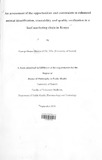| dc.description.abstract | The objective of this study was to assess the feasibility of implementation for an electronic Livestock Identification and Traceability System (LITS) in Kenya. It was envisaged that LITS would enable Kenya 1) ascertain origin and ownership of livestock and to discourage stock theft and thus livestock related insecurities; 2) support disease surveillance and minimise the spread of trans-boundary animal diseases (TADs); and 3) improve external market access through exports.
The study was implemented in six steps. First, stakeholder awareness, mobilisation and public private dialogue, second a LITS model suitable for pastoral production system was designed with the involvement of the key stakeholders. Third, a technical evaluation of the model was carried out at field level along the north-eastern Kenya and coastal marketing chain. Fourth, an economic evaluation of the model was undertaken using a Benefit Cost Analysis (BCA). Fifth, the existing constraints (such as institutional, organisational and in processes) towards up-scaling the model at a national level were analysed and finally, appropriate
recommendations drawn up based on key findings from steps 1-5 (step six).
The study revealed that an electronic livestock identification and traceability system was technically feasible in pastoral areas in Kenya. Rumen boluses were found to be better identifiers compared to ear button tags, having a readability of 100% and no losses over the one-year duration. The cost, when calculated for the nearly three million beef cattle in arid and semi-arid lands (ASALs), was US$ 7.4/head for registration and US 7.3/head for annual maintenance. The ear button tags while exhibiting readability of 100% over the same duration had losses of nearly 6%, which fell short of The International Committee on Animal Recording (lCAR) recommendations of minimum values >98% readability. The cost per head for ear button tags was estimated at US$ 5.15 for registration and US$ 5.04 for annual maintenance.
The BCA revealed that the Net Present Valuel (NPV) of tITS was approximately US$ 350 million at 2007 prices and the Benefit Cost Rati02 (BCR) was 4.73 - implying that the return on investment was computed at nearly five times the unit cost per dollar. Similarly, for the ear button tag NPV was US$ 386 million and the BCR 7.43. Sensitivity analysis conducted on the data showed that the underlying assumptions were valid and the project was economically and technically viable and beneficial to implement for pastoral beef cattle in Kenya. The main challenges identified were limited competence of human resource, inadequate market support infrastructure and limited skills in the application of middle ware (equipment between the tag and computer such as reader and cables).
Furthermore, prior to the study, the country did not have a clear institutional and organisational framework under which
electronic LITS could be implemented. The study established that the cost incurred on establishing the system can be offset vide a modest increase in demand for beef in the domestic market or an increase in beef export demand equivalent. In conclusion, the study
noted that with full participation of stakeholders the implementation of electronic traceability systems was both technically and economically feasible in pastoral production systems in Kenya despite it being a costly undertaking.
1 When NPV is greater than zero it implies that the discounted value of future cash flows is greater than the initial investment and that there is an even higher return than desired.
2 Benefit Cost Ratio (BCR) refers to the ratio of discounted benefits and discounted costs of a project or program. It is often used as an indicative ratio that attempts to summarize the overall value for money of a project or program. The project or program would be economically feasible if the BCR was greater than 1. Ideally, because a BCA is a social level analysis, benefits should be valued on the basis of beneficiaries' Willingness to pay while costs are valued at opportunity cost of undertaking the project or program.
From the study- it is recommended that: -
· The public sector driven mandatory traceability with a high degree of private sector participation be adopted in Kenya and the region as part of the regular activities of the Departments of Veterinary Services.
· Rumen boluses should be used as identifiers because in spite of their initial higher purchase and maintenance costs they are tamperproof, subject to minimal losses during use and can be recycled up to ten times and over 30 years.
· It is recommended that a policy of cost sharing at the rate of 40-50%: 60-50% (private public) be apply for early adopters ofLITS.
· The application of the electronic identifiers should be supported by legislation and anchored in the Animal Diseases Control Act Chapter (CAP) 364 of the laws of Kenya in the short-term. In the long-term Branding Act CAP 357 should be repealed and replaced with a more inclusive animal identification and traceability act and provisions supporting its enforcement and monitoring made in other relevant Chapters of the Laws of Kenya such as the Stock Produce Theft CAP-355, Meat Control CAP 356, Cattle Cleansing CAP-358, Hides, Skin and Leather Trade CAP-359, Prevention of Cruelty to Animals CAP-360, Kenya Meat Commission Act CAP-363, Animal Diseases Act CAP-364 and Veterinary Surgeons Act CAP 366.
· Implementation of the LIT should be preceded by studies focusing on establishing a sustainable regional framework for implementing traceability systems with a well coordinated method of vertical and horizontal communication system, and
· Given the nature of human and animal movement for grazing, water and trade in the region it is recommended t~at Kenya, with the support of regional African Union Organizations including East African Community (EAC), AU-IBAR and Inter Governmental Authority Development, adopts a LITS that is harmonised regionally in terms of legal and technical requirements. | en_US |

